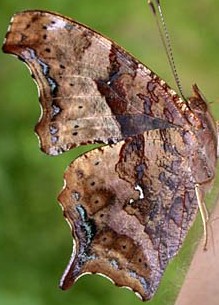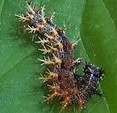 The Question Mark butterfly is in the genus with the common name of angelwings characterized by wings with ragged borders. They can be found east of the Rockies from southern Canada to Texas and Mexico and east to the Atlantic Ocean including Florida where they live in open sunny open spaces such as woodland glades, roadsides, parks, orchards, and streamsides. There are two forms; summer and winter. The upper side of the wings of the winter form is bright rust-orange with black spots. The hind wings of the summer form, however, are black. The hind wings of both forms have distinct tails although those of the winter form are longer and violet-tipped. The lower side of the wings of both forms are violet or red-brown in fall and spring, brown mottled with maroon and blue in summer. The underside of the hind wing has a marking that looks like a question mark giving the butterfly its common name. When the butterfly has its wings closed in looks like a dead leaf or the bark of a tree.The wing span is 2.25 to 3 inches.
The Question Mark butterfly is in the genus with the common name of angelwings characterized by wings with ragged borders. They can be found east of the Rockies from southern Canada to Texas and Mexico and east to the Atlantic Ocean including Florida where they live in open sunny open spaces such as woodland glades, roadsides, parks, orchards, and streamsides. There are two forms; summer and winter. The upper side of the wings of the winter form is bright rust-orange with black spots. The hind wings of the summer form, however, are black. The hind wings of both forms have distinct tails although those of the winter form are longer and violet-tipped. The lower side of the wings of both forms are violet or red-brown in fall and spring, brown mottled with maroon and blue in summer. The underside of the hind wing has a marking that looks like a question mark giving the butterfly its common name. When the butterfly has its wings closed in looks like a dead leaf or the bark of a tree.The wing span is 2.25 to 3 inches.
 Males rest on leaves or tree trunks in the afternoon watching for females an defending their territory. After mating the females lay their small, light green, keg-shaped, ribbed eggs singly or in vertical or horizontal strings of the lower side of
Males rest on leaves or tree trunks in the afternoon watching for females an defending their territory. After mating the females lay their small, light green, keg-shaped, ribbed eggs singly or in vertical or horizontal strings of the lower side of
 plant leaves. The leaves may be the host plant for the larva but often are not. The caterpillars that emerge are 1 5/8 inches long at maturity and bear branched spines on their heads and segments. They pupate and form a gray brown chrysalis with olive mottling. Adults overwinter.
plant leaves. The leaves may be the host plant for the larva but often are not. The caterpillars that emerge are 1 5/8 inches long at maturity and bear branched spines on their heads and segments. They pupate and form a gray brown chrysalis with olive mottling. Adults overwinter.
The larvae feed on elms especially American elm (Ulmus americana), winged elm (Ulmus alata) , and red elm (Ulmus rubra) but both trees have some horticultural problems. Two other host plants, hackberry (Celtis occidentalis) and sugarberry (Celtis laevigata) are trees of some merit. Nettles especially false nettle (Boehmeria cylindrica) and stinging nettle (Urtica dioca) are also favored host plants and are suitable for a wildflower garden or natural informal planting. False nettle, by the way, does NOT have stinging cells. Although Japanese hop (Humulus japonicus) is a host plant for Question Marks it can be very invasive so cannot be recommended as a garden plant.
Adult Question Marks prefer tree sap, rotting fruit, dung, and carrion. Planting fruit trees such as plum or cherry and allowing the fruit to rot is a possible way of attracting adult Question Marks, but be forewarned that they become drunk on fermented fruit. If their preferred food is not available they may visit flowers such as aster (Aster spp.), butterfly bush (Buddleja davidii), sweet pepperbush (Clethra alnifolia), and common milkweed (Asclepias syriaca).